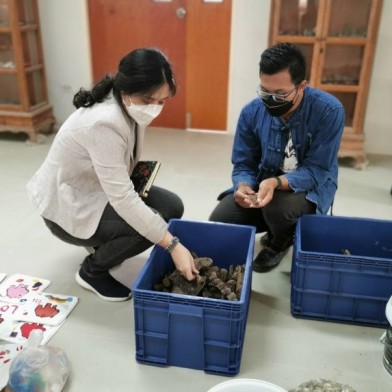When people think about young adults and South Korea, K-Pop is probably what springs to mind, but a new art form is rising to the top of Instagram feeds – visual art. Phoebe Taylor, Communications Adviser (Digital) at the Asia New Zealand Foundation was recently in South Korea as part of an arts tour that included a stop at one of the world's largest art fairs: Frieze. Here, she reflects on the emerging art trends she saw and the way younger generations approach the art world.
South Korea’s art scene is dynamic. Some people tend to still carry a traditional view of Asia, but it’s not just lanterns and dragons. With public artworks on nearly every corner in Seoul, dotted around the city you’ll also find large museums exhibiting works on gaming with VR immersion pods, alongside smaller galleries exhibiting works by sculptor Anish Kapoor with lines out the door.

A game machine in use at an exhibit in Seoul's National Museum of Modern and Contemporary Art. Image: Phoebe Taylor
I was recently in South Korea with a group of New Zealand art curators to attend the Frieze Seoul art fair with the Asia New Zealand Foundation Te Whītau Tūhono. While assisting the delegation and getting content from the ground, I heard insights from the group of art fair-savvy curators, but it was impossible not to notice how the art scene differs from Aotearoa.
Given the population of Seoul alone is five times the size of Aotearoa, you would expect everything to operate on a larger scale anyway, but visual art gets a special mention. Not only is there a heck of a lot of public artworks around, but there’s also a huge, growing market for private collections and acquiring works.
For the first time in 2022, South Korea’s art market reached 1 trillion won ($750.85 million), according to data from the Ministry of Culture, Sports and Tourism. And it continues to grow.
While I was, quite literally, walking through the art world in Seoul, I could see some notable emerging trends. There’s an emphasis on digital art and how it’s presented, and there’s also a rising trend of younger generations (Gen Z and millennials particularly) investing in the arts.

Younger generations in South Korea are looking to art as an investment. Image: Phoebe Taylor
The rise of digital art and the enthusiasm from young collectors was evident at Frieze Seoul. Frieze is an international art fair that draws artists, galleries, and patrons from across the world, exhibiting works from major institutions. For Kiwis, think of it as the Fieldays of the art world. Entering the fair in the COEX Centre, attached to the enormous, maze-like Starfield Mall, you could easily guess who the organisers were trying to impress with the digital signage and influencer-targeted foliage photo walls.
Frieze is where art trends emerge. Looking around, I could see the push digital art was making and even Whanki Kim ‘father of Korean contemporary art’ had his pieces digitised in an exhibition by LG OLED, signifying a new way to present work.
Walking around Frieze Seoul as someone only just under the ‘millennial’ age group, I didn’t feel out of place. There were attendees of all ages, particularly from younger age brackets. While I’m not at New Zealand art fairs every weekend, this shift in audience age surprised me.

The crowds at Frieze Seoul. Image: Phoebe Taylor
Seoul hosting Frieze is a big deal. It’s a recognition of Seoul’s growing significance as an art centre and it’s worth looking at what’s driving this art boom.
The assumption that art collecting and art fairs are only for older enthusiasts is not quite accurate. Gen Z and Millennials in South Korea are embracing newer ways of displaying and collecting art. They’ve grown up in the era of the internet, they’re not afraid of the transition to online platforms (anyone remember the hype of NFTs?) and they’re interested in exploring non-traditional pathways.
Investing in artwork as someone under 40 is becoming increasingly popular. In a report commissioned by the Korea Art Management Service (KAMS), Analysis of Korean Millennial and Generation Z Art Collectors, younger collectors (referred to in the article as ‘MZ’ – combining Millennial and Gen Z) are digital natives researching art through museum art classes and social media, and are apparently strongly influenced by celebrity art collector peers (including BTS’s RM, who posts about his passion for art and works from his collection, including a $1.2 million sculpture by American multidisciplinary artist Roni Horn).

Trends in the art world change over time and - in South Korea at least - now they're shifting further from physical pieces. Image: Phoebe Taylor
And while MZs might follow trends set by their idols, there’s another, simpler reason they buy art: they like it.
Art investing is often seen as a rich person’s game. It’s impossible not to acknowledge the privilege of being able to participate in the world of visual art and yet, we’re seeing young South Koreans willing to invest in art earlier on and recognise its future value, like the way New Zealanders seem to do with houses. Perhaps South Koreans see art as an innovative way to invest considering the difficulty of purchasing real estate, or perhaps they place a higher value on art in recognising its longer-term value?
Maybe we should take a leaf out of the MZ handbook and reevaluate where and what we place our value on. There’s a lot to be said about the impact that interest from young adults can have. Look at the well-used example of TikTok: over 700 million users worldwide are between the ages of 18 and 34. This age group is used to breaking stats and setting new records.

People pose with a sculpture of Gangnam Style hands. Image: Phoebe Taylor
Watching the trajectory of South Korea’s art scene and the engagement of younger demographics is fascinating, and we can see that it’s making a global impact with international art fairs drawing their attention to Seoul. Personally, I won't be investing in NFTs, but I'll keep watching K-Dramas and keeping an eye out for the latest trends.
- Asia Media Centre



